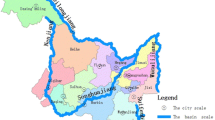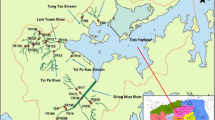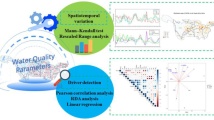Abstract
With overly-rapid socio-economic development and population increases, water abstraction for agricultural, industrial and municipal use increases rapidly, while the water left for ecological maintenance decreases greatly. At the same time, large amounts of polluted water are discharged into rivers because purification plants are inadequate or not built in time, causing serious eco-environmental problems in the Haihe river basins which make regional development unsustainable. Estimating eco-environmental carrying capacity related to water is a key to curbing overuse of water and resolving eco-environmental problems. Because of different trends in water resources development and resultant eco-environmental problems in different sub-basins of the Haihe river, there are different water-related eco-environmental carrying capacities (EECCs) in these sub-basins. Time-series and multi-objective optimization methods are used to determine the EECC in various eco-environmental regions of the Haihe river basins, China. The results show that the entirety of the Haihe river basins will not reach a stable, sustainable state until about 2033, through gradual amelioration of eco-environmental problems. The various eco-regions of the sub-basins will need different lengths of time to reach their own stable states because of different available water resources, eco-environmental problems and social and economic development.
Similar content being viewed by others
References
Arrow K, Bolin B, Costanza R et al. (1995) Economic growth, carrying capacity and environment. Science 268:520–521
Cheng G (2002) Evolution of the concept of carrying capacity and the analysis framework of water resources carrying capacity in northwest of China. Journal of Glaciology and Geocryology 24(4):361–367
Cui F (1998) The carrying capacity of municipal water environment and its case study. J Nat Resour 13(1):58–62
Dong CS, Xiong Y, Qin XH (2008) The spatial bearing capacity of tourism resources space in Zhangjiajie National Forest Park. Syst Eng 26(10):90–94
Downsa JA, Gatesb RJ, Murrayc AT (2008) Estimating carrying capacity for sandhill cranes using habitat suitability and spatial optimization models. Ecol Model 214:284–292
Feng LH, Huang CF (2008) A risk assessment model of water shortage based on information diffusion technology and its application in analyzing carrying capacity of water resources. Water Resour Manag 22:621–633
Feng Z (1994) The past, present and future of the study on soil carrying capacity. China Land Science 8(3):1–9
Gong L, Jin CL (2009) Fuzzy comprehensive evaluation for carrying capacity of regional water resources. Water Resour Manag. doi:10.1007/s11269-008-9393-y
Guo H, Xu Y, Hun Z, Zhao Z, Shao Q (1994) Water environmental planning for new zone of economic and technological development in China. Adv Environ Sci 2(6):14–22
Guo X, Mao X, Ran S (2000) Research progress in environmental carrying capacity in China. China Population, Resources and Environment 10(3):28–30
Haihe Water Conservancy Committee, State Water Conservancy Ministry (2000) Report of water resources layout in Haihe river basins
Jia R, Xue H, Xie J, Jiang X (1998) Research on the bearing capacity of regional water resources. Journal of Xi’an University of Technology 14(4):382–387
Jia R, Jiang X, Xue H, Shen B (2000) Study on bearing capacity of regional water resources. Journal of Lanzhou University (Natural Sciences) 36(2):114–121
Jiang X, Huang Q, Hui Y, Xue X (2001) Study on the models of bearing capacity of regional water environment. Acta Scientiae Circumstantiae 21(3):312–317
Lawson SR, Manning RE, Valliere WA, Wang B (2003) Proactive monitoring and adaptive management of social carrying capacity in Arches National Park:an application of computer simulation modeling. J Environ Manag 68:305–313
Li X (1996) Research on plough resource and supporting capacity in You County of Hunan Province. Acta Sci Nat Univ Norm Hunan 19(2):88–93
Li L, Guo H, Chen B, Sun H (2000) Water resource supporting capacity of Chaidamu Basin. Environ Sci 2:20–23
Li Q, Wang L, Zhang H, Yan X (2004) Research and prospect on theoretical framework of water environmental bearing capacity. Geography and Geo-Information Science 20(1):87–89
Liu Q, Yang Y, Jiang Z (2004) To discuss water resources carrying capacity in the context of sustainable development. China Water Conservancy 3:11–14
Liu RZ, Wang CW, Hao JM, Su BL, Ma YL (2009) Measuring environmental carrying capacity. Journal of Basic Science and Engineering 17(1):49–61
Long T, Jiang W (2003) Advances in water resources and water environmental carrying capacity. Adv Water Sci 14(2):249–253
Manning RE, Lawson SR (2002) Carrying capacity as “Informed Judgment”: the values of science and the science of values. Environ Manage 30(2):157–168
Mcleod SR (1997) Is the concept of carrying capacity useful in variable environment. OIKOS 79:529–542
Miao L, Wang Y, Zhang Y, Wang Q (2006) Assessing index system for bearing capacity of marine ecological environment. Mar Environ Sci 25(3):75–77
Odum EP (1972) Fundamentals of ecology. Saunders, Philadelphia
Qu Y, Fan S (2000) Water resources capacity and developing strategies in Heihe river basin. Journal of Desert Research 20(1):1–8
Prato T (2009) Fuzzy adaptive management of social and ecological carrying capacities for protected areas. J Environ Manag 90:2551–2557
Retzer V, Reudenbach C (2005) Modelling the carrying capacity and coexistence of pika and livestock in the mountain steppe of the South Gobi, Mongolia. Ecol Model 189:89–104
Simón GFJ, Narangajavana Y, Marqués DP (2004) Carrying capacity in the tourism industry: a case study of Hengisbury Head. Tour Manage 25(2):275–283
Tang J, Guo H, Ye W (1997) Environmental carrying capacity and its preliminary application in environmental planning. China Environ Sci 17(1):6–9
Wang JY, Du JH, Lü PR, Zhang Y, Mu JB (2008) The evaluation of water eco-environmental carrying capacity in Shandong Province. Journal of Shangdong University (Engineering Science) 38(5):94–98
Wang J, Jiang ZR, Che KJ (2007) Analysis on Tourist Environmental Bearing Capacity in the Yeliguan National Forest Park. Journal of Arid Land Resources and Environment 21(1):125–128
Wang S (1996) Study of regional water environmental carrying capacity and its sustainable use. Beijing Normal University Press, Beijing
Weng MH, Nie QY, Cai F, Nie QL (2009) Study on carrying capacity of water environment in Liaocheng City. Water Resour Protection 25(3):41–44
Wei B, Zhang X (1995) Study on rational use of urban water resource and water resource carrying capacity. City Environ Ecol 8(4):19–24
Xu X, Wang H, Gan H (1997) The methods and the theory of macro-economy water resource planning in North China. Water Resources Conservancy of Yellow River Press, Zhengzhou
Xu Z (1999) A scenario-based framework for multicriteria decision analysis in water carrying capacity. Journal of Glaciology and Geocryology 21(2):99–106
Xu Z, Cheng G (2000) A Study on the water resources carrying capacity by using the method of multiobjective optimization model-taking the Heihe river as an example. Journal of Lanzhou University (Natural Sciences) 36(2):122–132
Xu Z, Cheng G (2002) The predicted demand of water resources in the middle reaches of the Heihe river from 1995 to 2050. Journal of Glaciology and Geocryology 22(2):139–146
Zen W, Cheng S (1997) Preliminary suggestion on integrated planning of aquatic environment. Journal of Water Conservancy 10:77–82
Zhang C, Fang C (2002) Driving mechanism analysis of ecological-economical-social capacity interactions in oasis systems of arid lands. J Nat Resour 17(2):181–187
Zhang C, Fang C, Quan H (2002) Oasis capacity in arid region: reconsideration and prospect. Resour Sci 24(2):42–48
Zhang XL, Zhao YH (2007) Study on the dynamic change of the water environment carrying capacity of Hebei Province. Research of Soil and Water Conservation 14(3):259–262
Zhao RH, Cao SL, Gao HG (2005) Study on the bearing capacity of urban water environment and the strategy for sustainable development. Journal of Shandong University (Eengineering Science) 35(2):90–94
Zheng HX, Ren XH, Zhang YQ (2007) The evaluation on the influence of land utilization/cover to environment carrying capacity in countryside-Take Jianhu Country as a case. Territory & Natural Resources Study 3:4–5
Zhu YH, Drake S, Xia J, Jia SF, Lv HS (2005a) The study of eco-environmental carrying capacity related to water. In: Savic DA, Bertoni JC, Mariòo MA, Savenije HHG (eds) The red book for 7th IAHS scientific assembly—sustainable water management solutions for large cities. IAHS Publication 293. IAHS Press, Center for Ecology and Hydrology, Vallingford, UK, pp 118–124
Zhu YH, Xia J, Liu SX, Jia SF, Feng HL (2005b) Calculation of carrying capacity of eco-environments in Haihe River basins. Adv Water Sci 16(5):649–654
Author information
Authors and Affiliations
Corresponding author
Rights and permissions
About this article
Cite this article
Zhu, Y., Drake, S., Lü, H. et al. Analysis of Temporal and Spatial Differences in Eco-environmental Carrying Capacity Related to Water in the Haihe River Basins, China. Water Resour Manage 24, 1089–1105 (2010). https://doi.org/10.1007/s11269-009-9487-1
Received:
Accepted:
Published:
Issue Date:
DOI: https://doi.org/10.1007/s11269-009-9487-1




